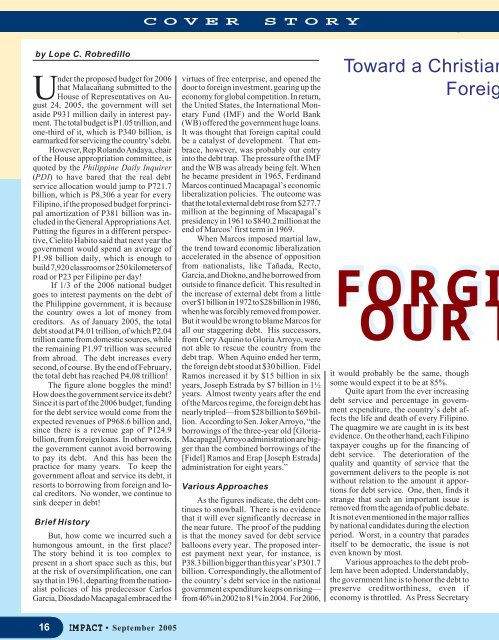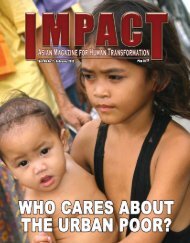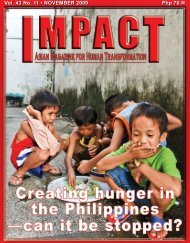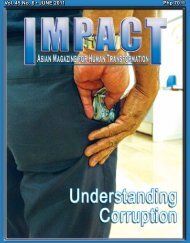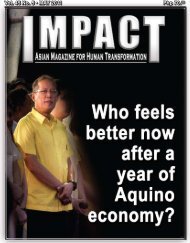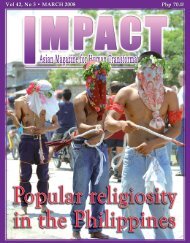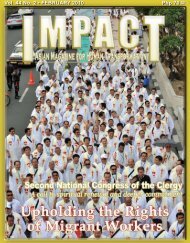SEPTEMBER 2005 Vol 39, No 6 • Php 70.00 Php 70.00 - IMPACT ...
SEPTEMBER 2005 Vol 39, No 6 • Php 70.00 Php 70.00 - IMPACT ...
SEPTEMBER 2005 Vol 39, No 6 • Php 70.00 Php 70.00 - IMPACT ...
- No tags were found...
You also want an ePaper? Increase the reach of your titles
YUMPU automatically turns print PDFs into web optimized ePapers that Google loves.
COVER STORY<br />
by Lope C. Robredillo<br />
Under the proposed budget for 2006<br />
that Malacañang submitted to the<br />
House of Representatives on August<br />
24, <strong>2005</strong>, the government will set<br />
aside P931 million daily in interest payment.<br />
The total budget is P1.05 trillion, and<br />
one-third of it, which is P340 billion, is<br />
earmarked for servicing the country’s debt.<br />
However, Rep Rolando Andaya, chair<br />
of the House appropriation committee, is<br />
quoted by the Philippine Daily Inquirer<br />
(PDI) to have bared that the real debt<br />
service allocation would jump to P721.7<br />
billion, which is P8,306 a year for every<br />
Filipino, if the proposed budget for principal<br />
amortization of P381 billion was included<br />
in the General Appropriations Act.<br />
Putting the figures in a different perspective,<br />
Cielito Habito said that next year the<br />
government would spend an average of<br />
P1.98 billion daily, which is enough to<br />
build 7,920 classrooms or 250 kilometers of<br />
road or P23 per Filipino per day!<br />
If 1/3 of the 2006 national budget<br />
goes to interest payments on the debt of<br />
the Philippine government, it is because<br />
the country owes a lot of money from<br />
creditors. As of January <strong>2005</strong>, the total<br />
debt stood at P4.01 trillion, of which P2.04<br />
trillion came from domestic sources, while<br />
the remaining P1.97 trillion was secured<br />
from abroad. The debt increases every<br />
second, of course. By the end of February,<br />
the total debt has reached P4.08 trillion!<br />
The figure alone boggles the mind!<br />
How does the government service its debt<br />
Since it is part of the 2006 budget, funding<br />
for the debt service would come from the<br />
expected revenues of P968.6 billion and,<br />
since there is a revenue gap of P124.9<br />
billion, from foreign loans. In other words,<br />
the government cannot avoid borrowing<br />
to pay its debt. And this has been the<br />
practice for many years. To keep the<br />
government afloat and service its debt, it<br />
resorts to borrowing from foreign and local<br />
creditors. <strong>No</strong> wonder, we continue to<br />
sink deeper in debt!<br />
Brief History<br />
But, how come we incurred such a<br />
humongous amount, in the first place<br />
The story behind it is too complex to<br />
present in a short space such as this, but<br />
at the risk of oversimplification, one can<br />
say that in 1961, departing from the nationalist<br />
policies of his predecessor Carlos<br />
Garcia, Diosdado Macapagal embraced the<br />
virtues of free enterprise, and opened the<br />
door to foreign investment, gearing up the<br />
economy for global competition. In return,<br />
the United States, the International Monetary<br />
Fund (IMF) and the World Bank<br />
(WB) offered the government huge loans.<br />
It was thought that foreign capital could<br />
be a catalyst of development. That embrace,<br />
however, was probably our entry<br />
into the debt trap. The pressure of the IMF<br />
and the WB was already being felt. When<br />
he became president in 1965, Ferdinand<br />
Marcos continued Macapagal’s economic<br />
liberalization policies. The outcome was<br />
that the total external debt rose from $277.7<br />
million at the beginning of Macapagal’s<br />
presidency in 1961 to $840.2 million at the<br />
end of Marcos’ first term in 1969.<br />
When Marcos imposed martial law,<br />
the trend toward economic liberalization<br />
accelerated in the absence of opposition<br />
from nationalists, like Tañada, Recto,<br />
Garcia, and Diokno, and he borrowed from<br />
outside to finance deficit. This resulted in<br />
the increase of external debt from a little<br />
over $1 billion in 1972 to $28 billion in 1986,<br />
when he was forcibly removed from power.<br />
But it would be wrong to blame Marcos for<br />
all our staggering debt. His successors,<br />
from Cory Aquino to Gloria Arroyo, were<br />
not able to rescue the country from the<br />
debt trap. When Aquino ended her term,<br />
the foreign debt stood at $30 billion. Fidel<br />
Ramos increased it by $15 billion in six<br />
years, Joseph Estrada by $7 billion in 1½<br />
years. Almost twenty years after the end<br />
of the Marcos regime, the foreign debt has<br />
nearly tripled—from $28 billion to $69 billion.<br />
According to Sen. Joker Arroyo, “the<br />
borrowings of the three-year old [Gloria-<br />
Macapagal] Arroyo administration are bigger<br />
than the combined borrowings of the<br />
[Fidel] Ramos and Erap [Joseph Estrada]<br />
administration for eight years.”<br />
Various Approaches<br />
As the figures indicate, the debt continues<br />
to snowball. There is no evidence<br />
that it will ever significantly decrease in<br />
the near future. The proof of the pudding<br />
is that the money saved for debt service<br />
balloons every year. The proposed interest<br />
payment next year, for instance, is<br />
P38.3 billion bigger than this year’s P301.7<br />
billion. Correspondingly, the allotment of<br />
the country’s debt service in the national<br />
government expenditure keeps on rising—<br />
from 46% in 2002 to 81% in 2004. For 2006,<br />
Toward a Christian<br />
Foreig<br />
FORGI<br />
OUR D<br />
it would probably be the same, though<br />
some would expect it to be at 85%.<br />
Quite apart from the ever increasing<br />
debt service and percentage in government<br />
expenditure, the country’s debt affects<br />
the life and death of every Filipino.<br />
The quagmire we are caught in is its best<br />
evidence. On the other hand, each Filipino<br />
taxpayer coughs up for the financing of<br />
debt service. The deterioration of the<br />
quality and quantity of service that the<br />
government delivers to the people is not<br />
without relation to the amount it apportions<br />
for debt service. One, then, finds it<br />
strange that such an important issue is<br />
removed from the agenda of public debate.<br />
It is not even mentioned in the major rallies<br />
by national candidates during the election<br />
period. Worst, in a country that parades<br />
itself to be democratic, the issue is not<br />
even known by most.<br />
Various approaches to the debt problem<br />
have been adopted. Understandably,<br />
the government line is to honor the debt to<br />
preserve creditworthiness, even if<br />
economy is throttled. As Press Secretary<br />
16<br />
<strong>IMPACT</strong> <strong>•</strong> September <strong>2005</strong>


